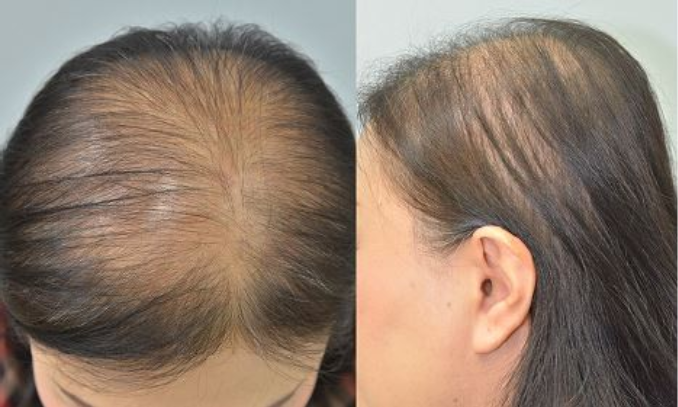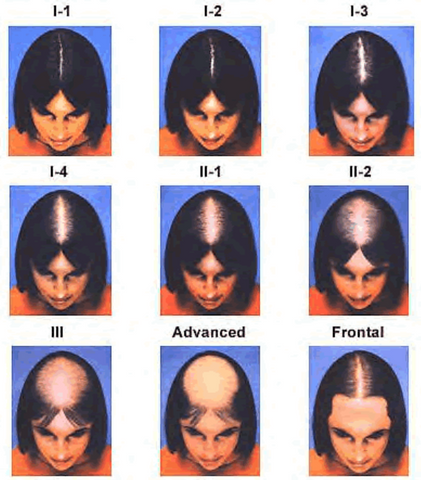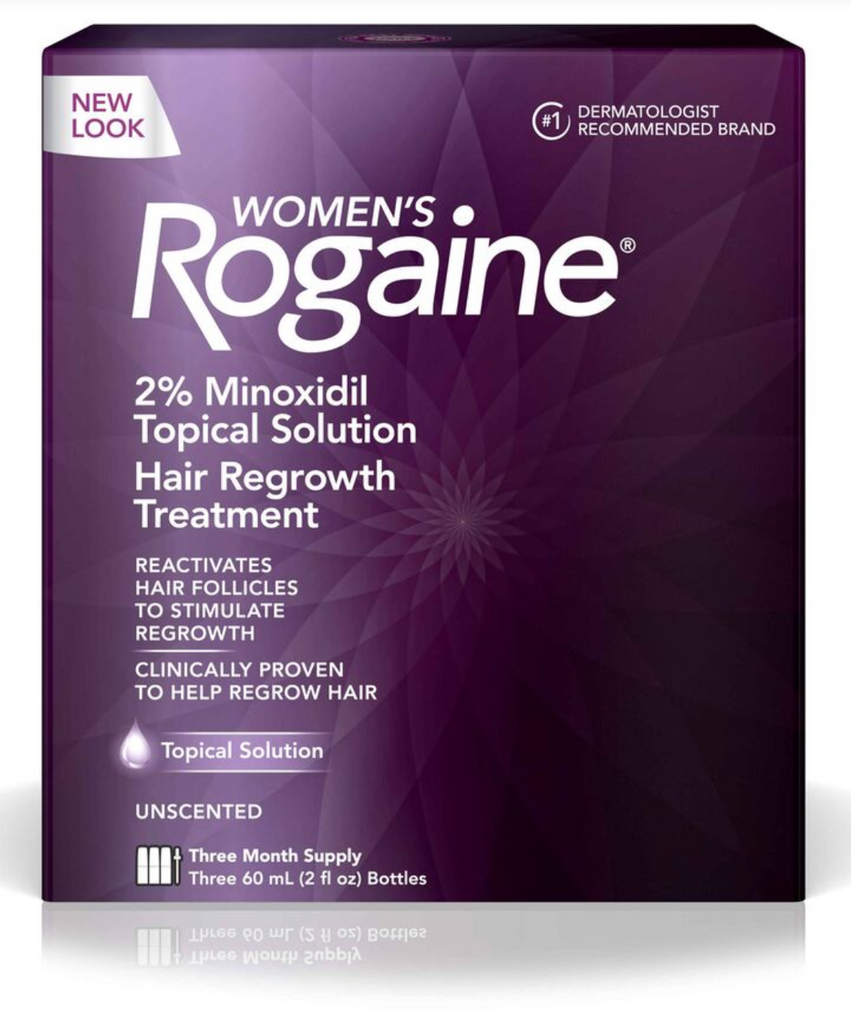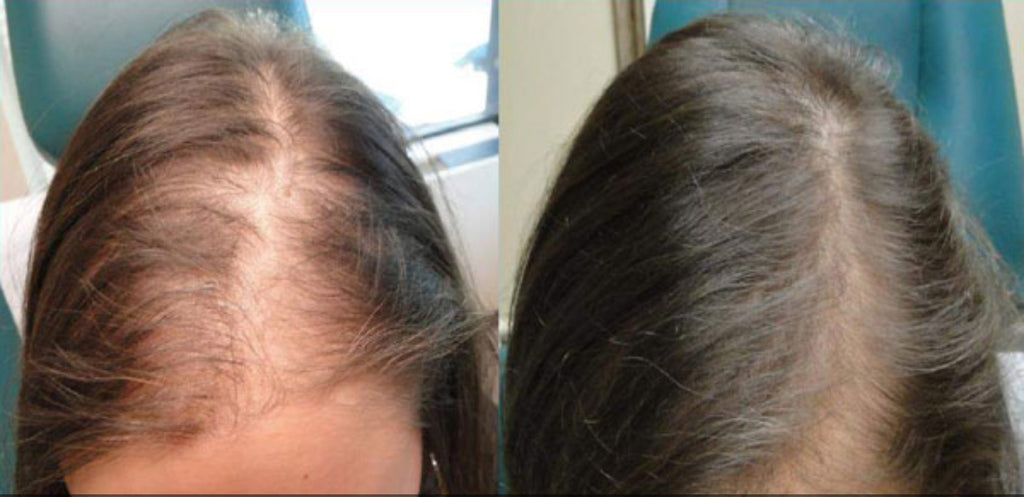Fighting receding hairline using minoxidil for women

Minoxidil for women is among the leading hair loss treatment applications in the world. Hair loss is commonly associated with men; however, women also experience this. The problem usually starts around after menopause in women but it could also start earlier, depending on other factors.
Hair loss can easily start in women as it does in men. Some causes of hair loss include age, stress, hormonal imbalance, among others. It also happens in various patterns. For some women, their hair starts thinning uniformly across the scalp. Other women may experience hair thinning from the center, with the gap getting wider and wider. In some cases, bald spots may appear at the crown of the head.
Regardless of how it happens, hair loss is a problem that requires a solution once it starts. In our latest blog post, we will look at how minoxidil for women is helping to bring back confidence in their lives. We will also discuss other alternative treatments such as Saw Palmetto, among other hair loss associated information.
What is hair loss
Hair loss is the gradual shedding of hair overtime without any regrowth. Usually, about 50-100 strands of hair fall daily; however, they regrow after about 6 months to a year. With hair loss, shedding increases to levels above 100 strands of hair daily, which is known as diffuse thinning. The hair follicles also break the hair growth cycle by failing to regrow lost strands. Breaking the cycle affects the natural planned shedding and growing of hair, which can easily lead to bald patches.

Can you measure hair loss in women?
Finding a few strands of hair on your brush or comb should not cause any alarm. However, if the number of strands gradually increases, you should consult a doctor.
Doctors use two scales to determine the level of your hair loss: the Ludwig Scale and the Savin Scale. Both scales are identical with the only exception being that the Savin scale measures the overall thinning. Hair loss levels range from no hair loss to severe (very rare) hair loss in women. You can view your level of hair loss as described by the American Hair Loss Association.
Depending on your level of hair loss, you can select a working solution from numerous choices. For mild hair loss, usually type I in the Ludwig Scale, you can style your hair to hide any signs of hair loss. The same is also possible for type II. It becomes difficult to hide the effects of hair loss once it gets to type III.
Signs of balding
What are the first signs of balding? Well, it all starts with an irregular shedding of hair. That usually indicates possible diffuse thinning in the near future.
In women, a common sign is an increasing gap in the part found on the crown of the scalp. This comes after continual hair loss at the crown of the head leading to hair thinning. It leads to a type I classification in the Ludwig Scale.

Circular or bald spots on the head also indicate possible baldness. It may start as an itch that leads to hair falling off. These circular patches increase in size and frequency of occurrence. When not checked, they could easily lead to female baldness.
Some incidences, such as stress, may cause a sudden loss of hair. Handfuls of hair may fall off when combing, a sign of baldness if left uncontrolled. In severe instances, such as radiation therapy, hair can easily fall off.
If you have any of these signs, then getting a working solution is crucial to prevent baldness.
Baldness triggers
Baldness can either start suddenly or gradually, depending on the triggers. There are several hair loss triggers that can easily lead to baldness in women, these include;
Genes
Inherited hair loss patterns are the most common cause of balding in both men and women. In both cases, it is known as Androgenic alopecia. The name comes from the hormone that triggers hair loss. Hair loss, in this case, happens gradually and in a predictable pattern. It starts at the crown of the scalp, thinning as it moves outwards, leading to baldness in women. Hair loss arising from inherited genes is usually triggered by age.
Medical conditions
Certain medical conditions can trigger hair loss patterns in women. For example, pregnancy, thyroid conditions, and menopause can lead to hormonal imbalance. The hormonal imbalance can lead to hair loss.
Conditions such as alopecia areata can also lead to baldness. In this condition, the immune system attacks the body’s own hair follicles, affecting the hair growth cycle. Hair loss is mostly experienced when hair follicles in the growing stage are attacked by the body’s immune system.
Infections such as ringworm can also lead to a sudden onset of hair loss. If left untreated, the infected area can remain bald.
Medical treatment of other diseases
Diseases like cancer require chemotherapy and radiotherapy. The therapies kill off the cancer cells, which is good for the body. However, they also kill good body cells, such as hair follicles, leading to hair loss after the treatment. Luckily, baldness from such therapies is short-lived. Hair starts growing as it used to once the treatment is completed.
Stress
Stress is implicated in various medical conditions including hair loss. A sudden physical or emotional stress can cause the body to shed large amounts of hair. The stress can cause hair follicles to move from the growing stage to the shedding stage, leading to a sudden onset of hair loss.
Some of the stresses include;
- Loss of blood from surgeries or childbirth
- Severe emotional stress
- Traumatic events such as accidents
Hair loss due to stress may last for more than 6 months.

Damaging hairstyles
Some hairstyles are damaging and can certainly lead to hair loss. Any hairstyle that involves pulling your hair tightly or one that irritates your scalp may lead to excessive shedding of hair, especially around the edges. Long-term use of such hairstyles may lead to permanent baldness.
Some hairstyle treatments can also cause one to go bald. Hot oil treatments can damage the scalp causing scarring. In the case of scarring, baldness can be permanent.
Diet
Reducing your protein intake suddenly can lead to unexpected hair loss. Excessive intake of Vitamin A can also affect your hair, causing more than average shedding.
Vitamin D hair loss related issues also exist. People who take in inadequate vitamin D risk baldness. Vitamin D is essential in preventing the autoimmune disease, alopecia areata.
Daily exposure to the sun for about 30 minutes is essential in keeping Vitamin D levels within the recommended range.
Treatment through minoxidil for women
For women with a receding hairline, minoxidil is among the best treatment options in the market. It was the first FDA-approved drug that treats female pattern baldness. The drug is also common as a treatment for male pattern baldness and for enhancing beard growth.

Minoxidil comes in three formulations: as a spray, foam, or solution. Most companies offer minoxidil in different strengths. The varying strength levels are to guide users on the best minoxidil product to use. For example, Rogaine, a popular American minoxidil brand, offers minoxidil in 2%, 5%, and 10% formulations.
Most experts advise using the 2% minoxidil for women formulation to avoid unwanted side effects. Higher strengths of minoxidil may lead to an overdose, resulting in side effects such as excessive hair growth. It can also result in beard growth in some women.
How it works
For hair to grow, it requires the right condition, both physically and mentally. One of the conditions is adequate blood flow to the scalp region.
Now, with female pattern baldness, the hair follicles shrink and become dormant over time. This reduces the active growth phase leading to weak, wispy hair. Minoxidil works by stopping hair follicle shrinkage and reversing its effects.
Firstly, minoxidil increases blood flow to the hair follicles in the scalp. Because the hair follicles receive more nutrients, they stop shrinking. With more blood flow, the hair follicles grow even larger, producing stronger hair.
Secondly, minoxidil also lengthens the hair growth phase. Hair grows in phases, which includes some period of dormancy. When using minoxidil, the active growth phase is lengthened, keeping your hair growth for longer.
The thickness and volume we see in hair come from having more active hair follicles. Minoxidil promotes thick and voluminous hair through its function of activating dormant hair follicles and keeping them active for longer during the growth phase.
Getting the best out of minoxidil for women
Minoxidil, on its own, results in hair regrowth; however, there are ways to get better results when using minoxidil.
For minoxidil to work, it needs to get to penetrate the skin. Most topical applications take some time before they get to their target area. In some cases, a very small percentage of the dose ends up getting to the target area. Therefore, to get the best out of minoxidil, most of it needs to penetrate the skin and get to the hair follicle.

The most effective way of increasing drug penetration through the skin is through microneedling. Microneedling punctures the skin, creating tiny holes that favor drug penetration. When you use minoxidil after microneedling, most of it gets to the hair follicle, and at a faster rate as well. The hair regrowth process then starts earlier, getting you more voluminous hair in a shorter time.
Moreover, microneedling is also known to trigger hair growth. It is one of the procedures doctors’ advice for patients with androgenic alopecia and other hair loss related conditions.
Saw Palmetto for hair
Apart from minoxidil for women, Saw Palmetto is also gaining popularity as an alternative treatment for hair loss in women. The Native American plant used in the past for treatment of various ailments is now synonymous with alternative hair loss treatment. In most cases, the extract, which is sourced from the Saw Palmetto berries, is what people apply on hair loss areas.
Various sites publishing information on the Saw Palmetto plant claim that it slows down androgenic alopecia, the most ordinary form of hair loss in both men and women.
How it works
According to the Journal of Cutaneous and Aesthetic surgery, Saw Palmetto works by inhibiting an enzyme that affects the conversion of testosterone to Dihydrotestosterone (DHT). Results from the study back claims that the extract reduces androgenic alopecia.
Dihydrotestosterone levels contribute to the onset and progression of androgenic alopecia. These levels increase when testosterone is converted to dihydrotestosterone, a reaction catalyzed by the 5-alpha-reductase enzyme. By blocking the action of the enzyme, it reduces the levels of DHT in the body, which slows down androgenic alopecia.
Experts believe that Saw Palmetto decreases the uptake of DHT into the hair follicles. They also suggest that the extract decreases the binding of DHT to androgenetic receptors.
Using Saw Palmetto
Because regulations around the plant may not be as strict as is with minoxidil, source your extract from reputable sources. The extract comes in two forms,
- A topical application
- As a pill
Each Saw Palmetto form reduces androgenic alopecia; however, the topical form is more favorable as its side effects are rare. To get the best out of the saw palmetto extract, microneedle before applying it. Microneedling will help your body absorb the extract, leading to faster effects of the product. It will also initiate hair growth in its own way, to amplify the effects of the Saw Palmetto extract.
Though rare, when using Saw Palmetto, you may experience the following side effects,
- Nausea
- Stomach pain
- Vomiting
- Headache
- Dizziness
The side effects depend on the route of the drug.
Minoxidil for Women vs. Saw Palmetto
-
Proven works. Both Minoxidil for women and Saw Palmetto are effective, as explained earlier; however, only minoxidil is widely proven. There are numerous research papers on the effects of minoxidil on hair. Minoxidil is also approved by the FDA as a result of its proven hair-growth effects. Testimonials on the effects of minoxidil are also numerous, compared to those of Saw Palmetto.
- How they work. Saw Palmetto works by reducing the conversion of testosterone to DHT. This is important in reducing hair loss. On the other hand, minoxidil works by lengthening the growth phase and activating dormant hair follicles, leading to voluminous, longer hair.
- Sourcing. It is easier to find minoxidil than Saw Palmetto. There are many online outlets and brick-and-mortar stores that sell minoxidil. Given that it is FDA-approved for hair growth, stores find it easier to stock. It is also easier to recognize reputable and stand out minoxidil brands, such as Rogaine.
- Value for money. Saw Palmetto is generally cheaper than Minoxidil; however, you are likely to see better results from minoxidil. Because of how it works, minoxidil for women is arguably a better deal than Saw Palmetto.
Combining both treatments to get the best of both drugs is also a possibility. There are no recorded side effects resulting from the use of both drugs, which is encouraging.
With Saw Palmetto preventing further hair loss and minoxidil increasing hair volume and length, the two can form a formidable hair loss-treatment pair.
Takeaway
Hair loss affects more than a third of women in their lifetime. The problem is amplified in postmenopausal women. Hair loss takes place in different patterns depending on its cause. To determine the extent of hair loss, experts created two scales: the Ludwig Scale and the Savin Scale. If left untreated in the early stages, hair loss will lead to baldness.
There are various treatment options for hair loss, including minoxidil and Saw Palmetto. Minoxidil is widely known, with proven hair growth effects. Compared to Saw Palmetto, Minoxidil has more backing from the scientific world.
To amplify the effects of both Minoxidil for women and Saw Palmetto, we advise microneedling. The procedure will greatly improve your hair growth time. It will also add in its own hair growth benefits. You can purchase quality microneedling devices from JJ ELLIE.




Leave a comment